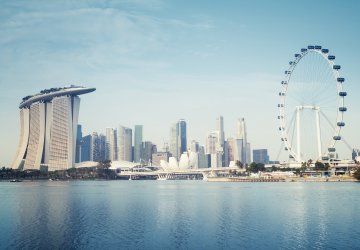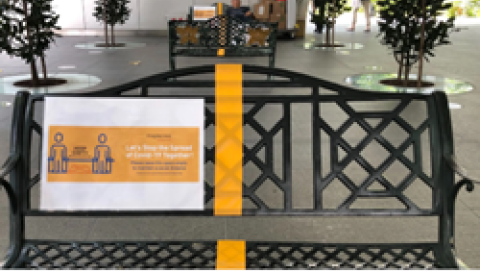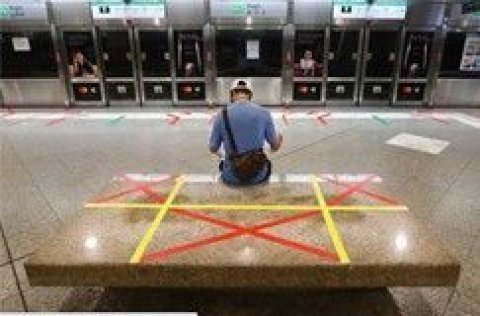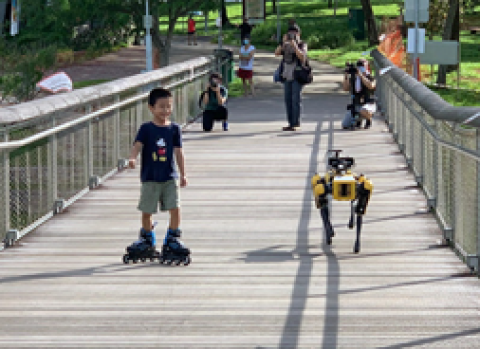
In a city with over 5 million people crammed into 725 km2 (social) distancing does not come easily. The Lion City - known for its severe fines, but also for a highly effective public bureaucracy - has treated 'social distancing' like a science.
Singapore is a global logistics and transport hub, with its airport, Changi, being one of largest and busiest in the world and connecting over 100 countries. With an estimated 3.4 million people travelling annually between Wuhan and Singapore, COVID-19 had the potential to pose a significant threat. However it’s interesting to note that the rate of coronavirus infection spread in Singapore has been one of the lowest worldwide.
Singapore’s response to the coronavirus has thus been viewed by many around the world as a model to emulate. Having learned valuable lessons from the past SARS outbreak, the city-state took prompt actions. As a pragmatic first-response solution, a whole new set of symbols popped up right across the island at food courts, parks and shopping centres illustrating how to social distance to limit the spread of the virus.
As more was learned about this disease, the Singapore government progressively implemented numerous control measures such as strict travel bans, contact tracing, ‘circuit breaker,’ compulsory mask-wearing, social distancing and limited social gathering policies.
As a smart nation that inclines towards technology and digitalisation, the infrastructure for home schooling, working from home, and online classes for self-study was in place when the circuit breaker came into operation at the beginning of April 2020.
While some countries were still discussing how many laptops would be needed for schools, robotic dogs were deployed to patrol Singapore’s parks. Each of these robots was fitted with a camera to monitor human traffic in the park and also broadcasted social-distancing messages to park users.
The Singapore authorities were serious about ensuring people complied with the measures imposed. The Singapore police have been trialling pilotless drones to enforce social distancing. In June this year, based on security camera footage, seven people were caught flouting COVID-19 laws by illegally congregating, socialising in a large group and drinking alcohol in a public area. These people were ‘publicly shamed’ as their identities, names, ages and nationalities were published in the newspaper, and in addition each received a fine of between S$8,000 and S$9,000 (ca. 5000 – 5700 Euro).
Government officials actively provide communications about the pandemic development and -maybe the most remarkable aspect from my (European) perspective - guidelines and directives are widely accepted and complied with by most of the population. The politicisation of wearing masks and those unproven colourful conspiracy theories related to the virus that have popped up in various other countries are non-existent in Singapore.
Returning to the workplace
The number of new COVID-19 cases in Singapore has decreased drastically from mid-August 2020 to a few dozen per day, and there have been no new waves of contamination since then. The city is now preparing to gradually reopen its economy and people are beginning to return to their workplaces.
While social distancing has become a buzzword around the globe, Singapore has elevated it from a vague concept to a very specific set of guidelines. Companies must stagger their start times across at least three one-hour blocks to reduce congestion on public transport during morning rush hours. They are to organise their employees into groups and put them on a rota system, so at any one time no more than 50% of the employees are working in the office while the other half is homeworking and vice versa.
In order to comply with these guidelines, companies need to be in control of their utilised space density and associated services like timely cleaning of facilities. For building access control, facial recognition technology has been used. Thermal temperature screening and safe entry registration via QR codes are common sights for crowd monitoring and case detection. Integrated IWMS systems will help to facilitate and monitor split-team arrangements and allow employees to book available flexible desks using their own devices.
To support organisations in facilitating a safe return to the workplace, Planon has defined a number of use cases around processes such as: visitor registration, access management, reservations, cleaning management, indoor air quality monitoring and service request management. Planon COVID-19 use case options generated considerable interest from our community. With most of the base data already available in the system, adding the additional functionality to support and measure compliance with new COVID guidelines becomes an easier exercise. In addition, Planon has recently launched a brand new mobile solution for workplace users - the Planon Workplace Engagement App. This app supports a friction-free work environment and touchless user experiences that contribute to a safe return the office.
With digital affinity in Asia and an openness to embrace and adopt new technologies, one may expect the transition to the ‘new normal’ to happen smoothly in Singapore; which was ranked number one Smart City of the world for the second year running in 2020. Hopefully it will not be too long before we can resume a somewhat normal (work) life.

























